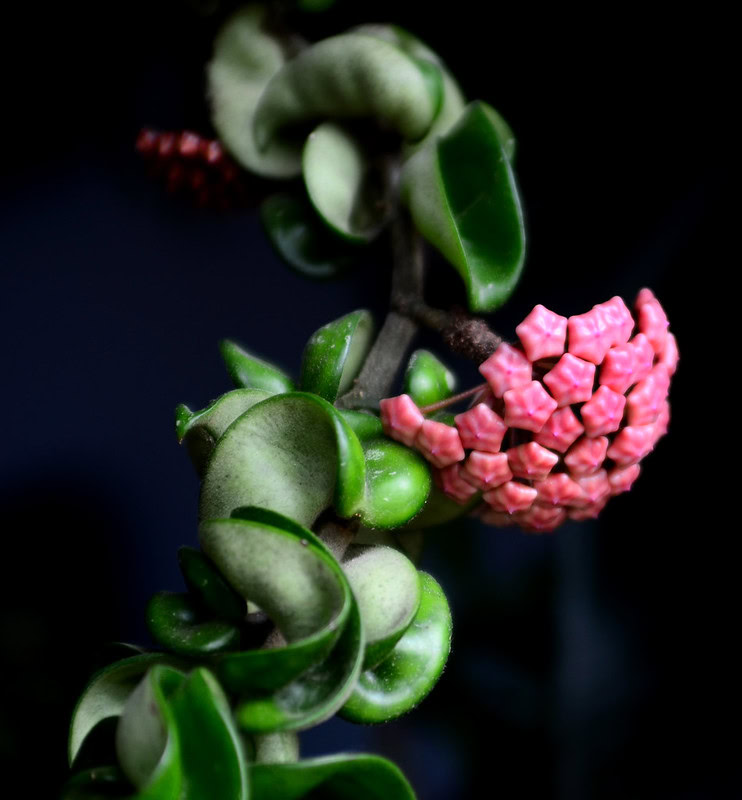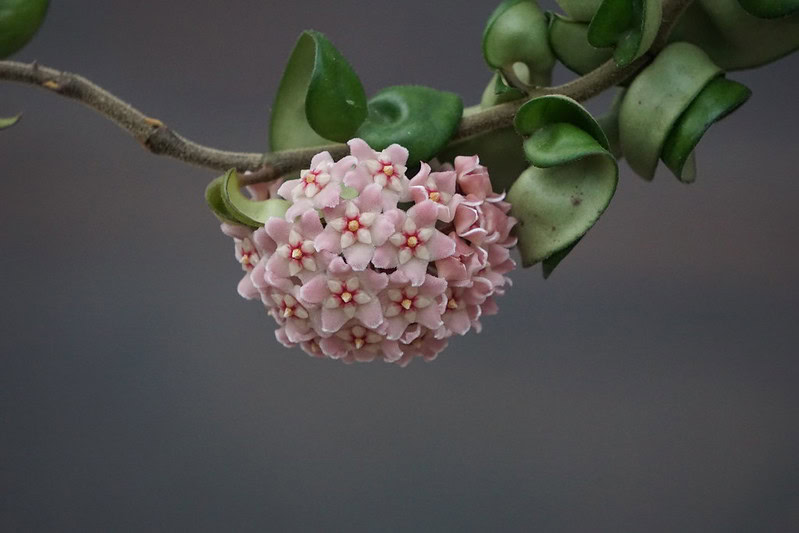The Hindu Rope Plant, scientifically known as Hoya carnosa compacta, is a captivating succulent appreciated for its unique trailing vines and waxy, rope-like leaves.
Native to the southern regions of India and East Asia, this plant is a member of the Hoya genus and is renowned for its resilience and distinctive appearance.
Here’s a comprehensive guide on how to grow and care for Hindu Rope Plants:
| Attribute | Description |
|---|---|
| Botanical Name | Hoya carnosa compacta |
| Common Name | Hindu Rope Plant, Krinkle Kurl, Wax Plant |
| Family | Apocynaceae |
| Plant Type | Succulent Vine |
| Mature Size | Up to 20 feet in length (when allowed to trail) |
| Sun Exposure | Bright, indirect light |
| Soil Type | Well-draining potting mix |
| Soil pH | Slightly acidic to neutral |
| Bloom Time | Typically in late spring to early summer |
| Flower Color | Clusters of pink, reddish, or white star-shaped flowers |
| Hardiness Zones | 10-12 (USDA zones) |
| Native Area | East Asia, Australia, and some Pacific islands |

Growing Conditions:
- Light:
- Hindu Rope Plants thrive in bright, indirect light. They can tolerate some direct sunlight, but prolonged exposure may lead to leaf burn. Place them near a window with filtered sunlight or use sheer curtains to diffuse light.
- Temperature:
- Maintain temperatures between 60°F to 75°F (15°C to 24°C) during the day and slightly cooler at night. Protect the plant from drafts and sudden temperature fluctuations.
- Soil:
- Use a well-draining potting mix specifically formulated for succulents or orchids. A mix containing perlite or sand helps prevent overwatering and root rot.
- Container:
- Choose a pot with drainage holes to ensure excess water can escape. Hindu Rope Plants prefer being slightly root-bound, so select a container that allows for some snugness without being too restrictive.
Watering:
- Watering Frequency:
- Allow the soil to dry out between waterings. Hindu Rope Plants are succulents, and overwatering is a common issue. Water sparingly, especially during the dormant winter months.
- Watering Technique:
- Water thoroughly and ensure excess water drains away. Empty the saucer beneath the pot to prevent waterlogged conditions.
- Humidity:
- Hindu Rope Plants can tolerate normal household humidity, but they appreciate slightly higher humidity levels. Regular misting or placing a tray of water near the plant can provide additional moisture.
Pruning and Maintenance:
- Pruning:
- Trim back leggy or unruly vines to maintain a compact and bushy shape. Pruning can also encourage the plant to produce more blooms.
- Cleaning:
- Wipe the waxy leaves with a damp cloth to remove dust. This enhances the plant’s ability to absorb light and nutrients.
Flowering:
- Blooms:
- Hindu Rope Plants produce clusters of star-shaped, waxy flowers with a pleasant fragrance. Blooms usually appear on mature plants, and the frequency depends on factors like light and temperature.
- Bud Formation:
- Adequate sunlight and slightly cooler temperatures can stimulate bud formation. Be patient, as it may take time for buds to develop.
Propagation:
- Propagation Method:
- Hindu Rope Plants can be propagated through stem cuttings. Take a healthy cutting with at least two leaves and allow the cut end to callus before planting in a well-draining mix.
- Rooting Time:
- Rooting may take several weeks, and it’s advisable to provide consistent, indirect light during this period.
Common Issues:
- Overwatering:
- The most common issue is overwatering, leading to root rot. Ensure the soil dries out between waterings to prevent this.
- Pests:
- Keep an eye out for common pests like mealybugs and spider mites. If detected, treat with insecticidal soap or neem oil.

Types of Hindu Rope Plants
The Hindu Rope Plant (Hoya carnosa compacta) is a specific cultivar of the Hoya carnosa species. While there may not be distinct “types” of Hindu Rope Plants, variations and cultivars can occur based on factors such as leaf color, variegation, or growth habits. Here are some variations you may find:
- Hoya carnosa compacta:
- The standard Hindu Rope Plant with twisted, curled, or rope-like leaves.
- Variegated Hindu Rope Plant:
- Some varieties may exhibit variegation, where the leaves have patterns of different colors, adding visual interest.
- Hoya carnosa ‘Krinkle 8’:
- A specific cultivar is known for its eight creases or wrinkles along the leaf edges.
Conclusion:
Hindu Rope Plants are not just houseplants; they’re captivating additions to your indoor garden. By providing the right conditions and attentive care, you can enjoy the unique charm of these succulents as they gracefully trail and bloom, adding a touch of exotic beauty to your living space.
FAQs
- What is a Hindu rope called?
- The Hindu Rope Plant is scientifically known as Hoya carnosa compacta. It is commonly called the Hindu Rope Plant due to the twisted, rope-like appearance of its trailing vines.
- How do you take care of a Hindu Hoya?
- Provide bright, indirect light.
- Water when the top inch of soil is dry.
- Use well-draining soil.
- Maintain average room humidity.
- Keep temperatures between 60-75°F (15-24°C).
- Is Hindu Rope Plant poisonous to cats?
- Yes, the Hindu Rope Plant (Hoya carnosa compacta) is considered toxic to cats. It contains substances that can cause mild to moderate gastrointestinal upset if ingested.
- Is a Hindu Rope Plant a succulent?
- Yes, the Hindu Rope Plant is classified as a succulent. It stores water in its thick, fleshy leaves, allowing it to endure periods of drought.

